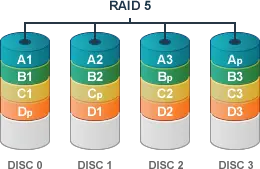
Data Distribution in a RAID 5
If you notice a problem with the storage system, if an orange (or yellow, or other) light is flashing on the device, or if it displays error messages when you try to access the device, shut it down immediately and do not allow it to attempt a rebuild.
The cost for these cases depends on many factors.
Some of these factors are the type of RAID (RAID 5 is more expensive than RAID 0 as it requires time-consuming analysis and special techniques), the file system (NTFS, FAT, XFS…), the capacity of the drives, etc.
You can get an idea of the cost here.
Of course, the cost mentioned is approximate and not binding. The exact cost can be determined only after the diagnostic check.
The diagnostic check is FREE. Send us a RAID array now.
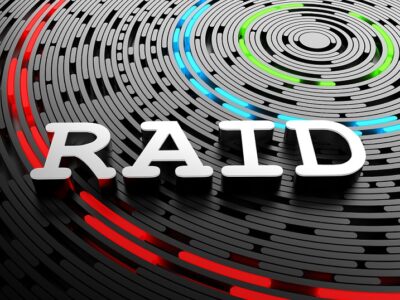 We receive the drives that made up the RAID array and perform the typical diagnostic check.
We receive the drives that made up the RAID array and perform the typical diagnostic check.- If the drives are healthy, we create clones on our secure storage media. If they have damages, we fix them.
- The parameters of the RAID are identified:
If there is a hot spare, which drives contain files, if there is a delay, what the file system is, what the stripe size is, what the order of the drives is, etc. This step can often be extremely complex. - A virtual array of drives is set up using the parameters identified in step 3.
- Partition analysis is performed to extract functional data.
- The recovered data is checked for functionality and integrity.
- The result is communicated to the client.
For any questions or clarifications, contact us.
It is good for us to know as many details as possible about the history, what exactly happened to cause the RAID to fail, why the SERVER failed, and what activity was occurring at that moment.
Also, we need to know what actions were taken before the array arrived at our labs.
The more details we know, the better.
Finally, it is good for us to know details about the data you want to recover.
If possible, note down on paper as many details as you know about the RAID system: Number of partitions, total data volume (approximately), file types we are looking for.
We usually don’t need the entire Server, just the drives.
It is good to know the model of the Server and the RAID Controller it uses, but this information is not absolutely necessary.
Yes, of course.
We recover data from all types of RAID.
We do not limit ourselves to the most common RAID0, RAID 5 & RAID 10.
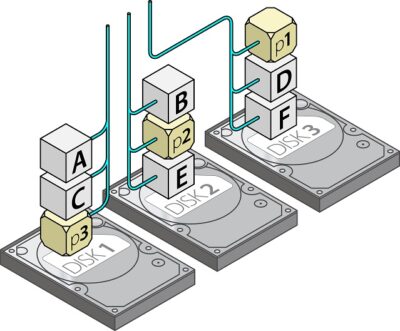 No.
No.
The charge is the same whether we recover 1 MB or many TB.
The reason is that in order to retrieve even one file from the drive, the process must be completed (RAID analysis, reassembly, etc.).
Therefore, the number of files you request only affects the recovery time and not the cost.
⇒ Data recovery cannot be performed on RAID arrays where attempts have been made by people who do not know what they are doing, or at best, it will require an exceptional amount of manual repair of the array.
⇒ Data recovery cannot be performed when there is insufficient number of drives that are functional or recoverable.
For example, in a RAID5 array with 4 drives, if 2 of them have damaged surfaces, then recovery of the array is impossible.
⇒ Also, incorrect attempts at rebuilds, checkdisk after the array has presented a problem, and incorrect user actions can be fatal to the data.
The experienced technicians at Northwind Data Recovery, even in these cases, will exhaust every possibility to recover the data from the RAID.
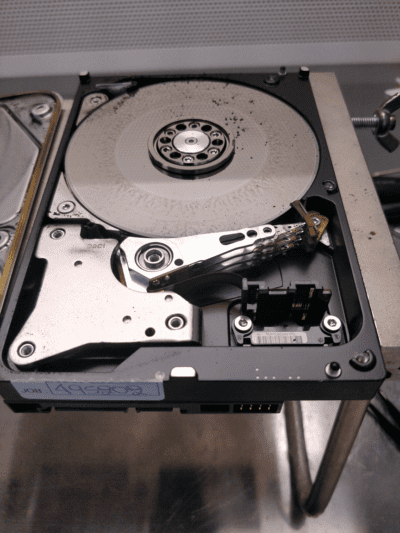
Hard drive powered on after being exposed to dust from opening in a non-controlled environment.
Unfortunately, yes. Hard drives have their sensitive mechanical parts in a sealed environment and should not be exposed to the atmosphere.
Exposure to atmospheric air means they are “contaminated” by dust particles, moisture, etc. Especially if you attempted to “tamper” with the drive by meddling with its mechanical parts (e.g., trying to spin the platters by hand, attempting to remove the read head, etc.), there is a 99.9% chance you have rendered it unrecoverable.
DO NOT ATTEMPT TO INTERVENE IN THE DRIVE’S INTERIOR.
It consists of mechanical parts that should be accessed by specialized personnel with the corresponding equipment, experience, and expertise.
There are parts of the drive that are adjusted robotically at the manufacturer’s factory and do not accept human intervention.
Any attempt you make will make the recovery work significantly more expensive and more difficult, if not impossible.
If you have already made the mistake of intervening in the drive, you can send or bring the drive(s) to us if it is a RAID array. We will examine the damage that has been done and inform you accordingly.
However, it should be emphasized that in this case, the cost will be higher than usual.
Before the recovery process is completed, you will be informed about the recoverable files.
This will be done either by phone if the files you are interested in are few or a list of files that can be recovered will be sent to you.
This way, you can check if your valuable data is included in the files we can recover for you.
Of course, if your data cannot be recovered, the recovery process stops, and you will not be charged anything.
We understand that RAID arrays typically contain professional data and the recovery time is critical.
RAID arrays are always prioritized in our labs.
The recovery time depends on various factors, such as the type of drives, the filesystem, the volume of data, the complexity of the system, etc.
Assuming your system is NTFS RAID 5 with 4 disks of 2TB, you can expect to have your data in 1-2 days.
The receipt of the media is conducted with a private agreement between both parties, which ensures the customer against any use of their data. We guarantee that confidentiality is of utmost importance to us.
Northwind Data Recovery fully complies with GDPR regulations.
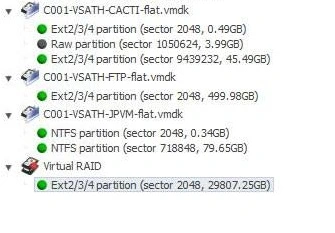
Data recovery on an array with virtual machines and virtual disks (vmdk, vhdx)
No.
The disks need to be cloned and analyzed (with the optimistic assumption that they are relatively healthy and won’t require Clean Room intervention, etc.) and this can be done only in our labs.
You can provide us with a drive on which you would like the data to be written, or we can supply a drive at retail price.
We can also upload the data to a cloud in encrypted form and send you the decryption key separately.
The disks must be wrapped VERY carefully before being sent to us by courier.
We have encountered cases where the condition of the disks significantly worsened during transport due to vibrations.
- Wrap the disks with bubble wrap and use a box with dimensions approximately the size of the disks along with the wrapping.
- Fill the gaps with paper, newspapers, or other soft foam material.

